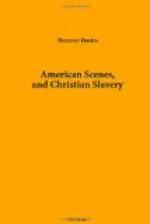13 + 4 = 17 total of places of worship.
DOLLARS.
The Salary of the Governor of Connecticut is 1,100
" Lieutenant
" . . 300
" Rev.
Dr. Bacon . . . 1,500
" Rev.
Mr. Dutton . . . 1,500
In the middle of the day, we leave by railway for Hartford, 36 miles off. Dr. Hawes is our fellow-traveller. Coloured people are here allowed to travel in the same carriages with others. It was not so, even on this line, three or four years ago, when the Rev. Mr. Pennington was setting off from Hartford for England. He told me himself that he was obliged on that occasion to travel in the luggage-van. On our arrival, we are met by Charles Hosmer, Esq., (a cousin of Elihu Burritt,) an old and valued correspondent of mine, and of my predecessor Mr. Wray. To both of us he had occasionally sent presents of excellent American publications. We must be his guests during the few days we remain at Hartford. Dr. Hawes and Chief Justice Williams, came in a homely way to spend the evening with us. The Chief Justice is a deacon of the Doctor’s church, and a teacher in the Sabbath-school.
The next day we were taken to see the Deaf and Dumb Institution. This asylum was founded by the Rev. Mr. Gallaudet, who, becoming deeply interested in this class of afflicted humanity, visited England and the Continent with a view to obtain information as to the best mode of communicating instruction to them. I may also observe that he himself married a deaf and dumb lady, by whom he has a large family of children, now grown up, none of whom however inherit the maternal affliction. His son also has married a lady who, like his mother, is deaf and dumb. We were highly delighted with the success of the undertaking as seen in the comfort, cheerfulness, and proficiency of the pupils. In coming out, we met at the door a respectable well-dressed man and a woman, both of them deaf and dumb, who had formerly been pupils here, had formed an attachment to each other, married, settled comfortably in life, and were now coming to pay a visit to their former home.
On our return we saw the celebrated Charter Oak. The early settlers of this place had obtained from the second Charles, and that in the very year in which 2,000 ministers were ejected from the Church of England, a most favourable charter—far more so than the Colonial Office in the present day would grant. Charles, however, repented having granted it, and in 1687 sent over Sir Edmund Andross, under some pretence or other, to demand it back. It was night, and the Legislative Assembly were convened on the subject, when suddenly the lights were extinguished, and the charter was missing. For a long time it was not known, except to the initiated, what had become of it. When, however, the danger was past, the Charter was forthcoming. It had been concealed in the hollow of this old oak, which still survives. I was gratified in seeing the document carefully preserved in the office of the Secretary of State. It is dated 1662, and “in the fourteenth year of our reign,” though in reality Charles had then reigned but two years.




